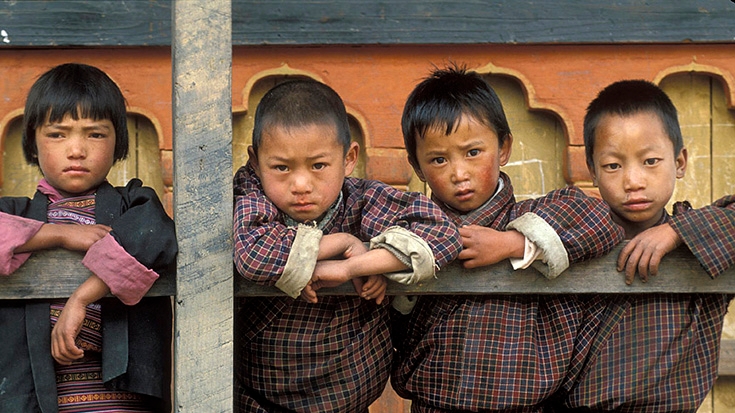Thimphu, September 17, 2014 – While Bhutan has made remarkable gains in reducing extreme poverty, sections of its population remain vulnerable to falling back into poverty, says the Bhutan Poverty Assessment Report. The Bhutan Poverty Assessment Report 2014 which was released by the National Statistics Bureau in collaboration with the World Bank at Thimphu today provides an account of the poverty outcomes observed under the country’s 10th Five-Year Plan (2008-2013).
In just over five years, from 2007-2012, the number of poor in Bhutan reduced by almost half - from 23 per cent in 2007 to 12 per cent in 2012. However for every two families that escaped poverty, one fell into poverty. The report asks for this trend to be addressed through a range of policy and economic measures in order to sustain the country’s significant achievements in poverty reduction over the longer term.
Bhutan’s poverty reduction record is unique in the South Asia region going by the internally comparable $1.25 purchasing power parity rate per capita per person. Despite having started in 1990 at almost the same level with other countries in the region, with more than half of its population in poverty, Bhutan has managed to reduce the percentage of poor to 4 percent in 2010 while the whole of South Asia’s poverty level had fallen to 30 percent.
“Economic growth in Bhutan has been pro-poor and the Five Year Plan adopted by the Royal Government of Bhutan prioritizes poverty reduction in a multi-dimensional way,” said Genevieve Boyreau, Country Representative, The World Bank. “But the risk of falling back into poverty remains greatest for Bhutanese in rural areas, those holding informal jobs, and with low level education. Bhutan needs to put in place protection mechanisms to enable the vulnerable sections of the population to sustainably rise out of poverty.”
Notable changes were visible in the profile of the poor and bottom 40 percent of the population in Bhutan between 2007-2012. Basic assets and amenities showed improvement with poorest households having access to improved housing, mobile phones and electricity. A significant improvement was also recorded in the dietary patterns among Bhutanese households with proportion of households consuming meat increasing from 46 percent in 2007 to 93 percent in 2012.
Much of the poverty reduction has taken place in rural areas. Rural Bhutan cut poverty by more than half between 2007 and 2012. In contrast, poverty increased in urban areas. The number of poor in urban Bhutan increased by 800 persons while in rural areas it dropped by 77,000.
“This study provides the much needed explanation – why poverty declined in Bhutan. Increasing commercialization of agriculture, expanding road infrastructure and economic boost from hydroelectric projects are found to be key factors aiding in poverty reduction”, said Kuenga Tshering, the Director General of the National Statistics Bureau.
The report highlights the role of commercialization of agriculture, development of highways and roads and hydropower projects as the main drivers of prosperity in rural Bhutan. The increased commercialization of agriculture due to renewed free trade agreements and preferential market access to neighboring countries in the region especially India and Bangladesh, led to an estimated 8 percent annual growth in crop production per hectare over 2006 to 2011(FAO 2014). As a result of improved road connectivity, school enrolment and completion rates increased due to reduced travel time and cost.
However, despite the tremendous progress made, the risk of people falling back into poverty remains, in particular for households engaged in agriculture and vulnerable to shocks. Studies have shown that female headed households (30 per cent of Bhutanese households are headed by women), despite matrilineal inheritance and a largely non-discriminatory labor market, are burdened with household responsibilities and are unable to take up better jobs. Bhutanese youth are at a comparative disadvantage in the job market due to lack of adequate skills.
However despite these issues, the current pace of poverty reduction appears sustainable in the medium term. In order to sustain the momentum achieved, the Report suggests:
· That the government should define and identify clear target groups for poverty reduction.
· Bhutan needs to manage risks and vulnerabilities by putting in place, for the poor and vulnerable segments of the population, formal social protection mechanisms along with access to finance mechanisms like targeted micro-credit programs and crop insurance. This would help farmers manage shocks due to price fluctuations and calamities.
· It is also suggested that a renewable resource rich country like Bhutan could encourage private sector led growth actively enabled by the public sector. Agribusiness, which is an emerging sector in Bhutan, needs to be developed and the government can put in place policies and incentives to encourage and support farmers in providing access to markets.
· The government’s plan to expand hydroelectric power production in Bhutan through 2020 will aid poverty reduction both directly and indirectly. The government could encourage private investment in hydropower sector using public private partnerships and subcontracting which in turn would create skills, jobs and help boost local economies in the project areas.

